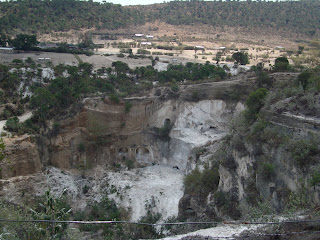Now that the trip is winding down, this is a good chance to reflect on what we came to this continent to do - teach.
A typical day:At our particular site, located in the International Christian Centre (we called it the ICC), a typical day started when we walked into the classroom at 8:15am. Class has a soft start at 8:30, and officially begins at 9:00. Most days, we'll arrive to find that a few students are already in the classroom, quietly working on their business plans. We help these early birds with their questions as we wait for everyone else to arrive.
Class starts with attendance and some opening remarks - we talk about everything, from an upcoming soccer (sorry - football) game with the other two classes, to an overview of what material we'll cover that day, to some comments about current business topics. Everyone is usually looking sleepy (particularly us instructors, since our guesthouse doesn't offer any coffee!), so we will often do a few stretches. Then the class begins in earnest.
From 9:00 until about 10:45, one or two instructors will cover the day's topic, which may be anything from completing a cash flow statement, to branding your company, to writing your company's mission statement.
At 10:44, everyone's ear is cocked to listen for the moment when one of the instructors will announce that it's TEA TIME! At our site, we have bread, butter, and tea set up for our students. To say the students 'enjoy' their tea would be a gross understatement... they waste no time in leaving their financial statements in the dust as they all clamber around the table for a snack, while shouting and chatting in Swahili.
After tea, we play a game (or more like we
try to play one game but it usually turns into four...) to get everyone energized again. Then it's back to the books. We usually spend the afternoon on a new topic, like revenues and expenses, or proper market survey techniques. Everyone is encouraged to get as involved as possible, so we often have students coming up to present their ideas or offer feedback. If it's a particularly complex topic, we'll split into three breakout groups (our group is called the Safari Skewers!), at a ratio of two instructors to six students, to discuss the concept further.
At 2:30pm, we wrap up the class and clean up the room. Many of the students often stay behind until 3:00 or 3:30pm to ask us questions about their business plans. All six of us instructors - from UBC and Strathmore University - meet after class to discuss what went well / not so well, and to discuss the next day's lesson plan. Then it's time to head back to our guesthouse so we can start it all up again the next morning!
Three weeks in a nutshellIt's been a memorable three weeks of teaching. Every day was fun, nerve-wracking, random, exciting, disastrous, and always, always an experience to remember. Here are some of the good, bad and ugly moments:
-
The bad: One of the toughest challenges we had - aside from dealing with a lack of electricity and running water on some days - was convincing some of the students that their business idea was simply not feasible. It's a terrible thing to see the light go out from someone's eyes when you tell them they have to rethink the plan that they are so passionate about... but as the days went on, it was encouraging for us to see the students thinking more critically and coming up with creative solutions to make their businesses more feasible.
-
The good: Seeing our students become leaders. We hosted an event where all three sites came together to network and play a hearty game of football, and it was heartwarming to see some of our shyest students take the initiative and lead the other students from all the sites in a round of icebreaker games. This was in spite of the fact that on Day 1 and 2, one of our students was so shy, his peers had to physically drag them into the classroom and judo-chop him into a chair before he would stay. Seeing him stand strong in front of his peers on the last day of class, proudly presenting his business idea, was a profound moment - one that brought tears to every instructor's eyes (the guys will complain the room was too 'dusty').
-
The ugly: Seeing some of the silly bloopers from students (bloopers that, truth be told, we must've made as well when we were junior students), like accidentally thinking variable cost was actually 'valuable' cost (as in jewellery)... or wondering why they couldn't get customers by "being physically aggressive"... or questioning why they
had to make a profit...
To say the last three weeks were a walk in the park would be a complete lie. There were times when we wanted to kill our students... and we're sure there were times when they definitely wanted to kill us!
But as we kept emphasizing in our classroom, we're a family. And so, we were all there for each other on graduation day, when each student walked across the stage to get his or her certificate, in celebration of what they had achieved.
The family doesn't end here - we look forward to keeping in touch with our students, and helping them along with their business ideas.







